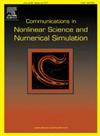Mechanical balance laws for the Nwogu system
IF 3.8
2区 数学
Q1 MATHEMATICS, APPLIED
Communications in Nonlinear Science and Numerical Simulation
Pub Date : 2025-09-30
DOI:10.1016/j.cnsns.2025.109370
引用次数: 0
Abstract
Boussinesq systems, first introduced by J. Boussinesq in 1872, model small-amplitude shallow-water waves with weakly nonlinear and dispersive effects. Over time, various forms of these systems have been developed. A common feature is their solution variables: the time-dependent free-surface elevation and horizontal fluid velocity in the water column. In 1993, O. Nwogu introduced a modified Boussinesq system by taking the solution variable at a specific fluid depth. This innovation significantly improved the linear dispersion properties, extending the applicability of Boussinesq systems to greater water depths. Due to these enhanced properties, the Nwogu system has become a widely used tool for nearshore wave modelling. While Boussinesq systems are commonly applied to small-amplitude long waves, the mechanical properties of these systems—such as mass, momentum, and energy—have received comparatively little attention, even for the Nwogu system. By leveraging the conservation principle, which states that the rate of change of a quantity in a spatial region equals the net influx into that region, mechanical balance laws can be derived for water wave models. This study derives mass, momentum, and energy balance laws for the Nwogu system in a two-dimensional domain with realistic bottom topography, ensuring accuracy consistent with the system’s asymptotic precision.
Nwogu系统的机械平衡规律
由J. Boussinesq于1872年首次引入的Boussinesq系统,模拟具有弱非线性和色散效应的小振幅浅水波。随着时间的推移,这些系统的各种形式被开发出来。一个共同的特征是它们的解变量:随时间变化的自由表面高程和水柱中的水平流体速度。1993年,O. Nwogu引入了一种改进的Boussinesq系统,采用特定流体深度下的溶液变量。这一创新显著改善了线性分散特性,将Boussinesq系统的适用性扩展到更大的水深。由于这些增强的特性,Nwogu系统已成为广泛使用的近岸波浪模拟工具。虽然Boussinesq系统通常应用于小振幅长波,但这些系统的力学性质——如质量、动量和能量——相对来说很少受到关注,即使是Nwogu系统。利用守恒原理,即空间区域中一个量的变化率等于该区域的净流入量,可以推导出水波模型的机械平衡定律。本研究在具有真实底地形的二维区域中导出了Nwogu系统的质量、动量和能量平衡规律,保证了精度与系统的渐近精度一致。
本文章由计算机程序翻译,如有差异,请以英文原文为准。
求助全文
约1分钟内获得全文
求助全文
来源期刊

Communications in Nonlinear Science and Numerical Simulation
MATHEMATICS, APPLIED-MATHEMATICS, INTERDISCIPLINARY APPLICATIONS
CiteScore
6.80
自引率
7.70%
发文量
378
审稿时长
78 days
期刊介绍:
The journal publishes original research findings on experimental observation, mathematical modeling, theoretical analysis and numerical simulation, for more accurate description, better prediction or novel application, of nonlinear phenomena in science and engineering. It offers a venue for researchers to make rapid exchange of ideas and techniques in nonlinear science and complexity.
The submission of manuscripts with cross-disciplinary approaches in nonlinear science and complexity is particularly encouraged.
Topics of interest:
Nonlinear differential or delay equations, Lie group analysis and asymptotic methods, Discontinuous systems, Fractals, Fractional calculus and dynamics, Nonlinear effects in quantum mechanics, Nonlinear stochastic processes, Experimental nonlinear science, Time-series and signal analysis, Computational methods and simulations in nonlinear science and engineering, Control of dynamical systems, Synchronization, Lyapunov analysis, High-dimensional chaos and turbulence, Chaos in Hamiltonian systems, Integrable systems and solitons, Collective behavior in many-body systems, Biological physics and networks, Nonlinear mechanical systems, Complex systems and complexity.
No length limitation for contributions is set, but only concisely written manuscripts are published. Brief papers are published on the basis of Rapid Communications. Discussions of previously published papers are welcome.
 求助内容:
求助内容: 应助结果提醒方式:
应助结果提醒方式:


